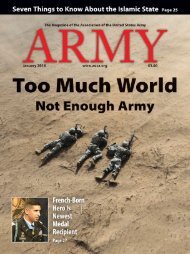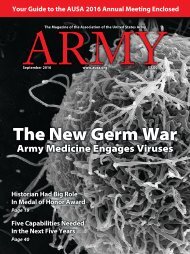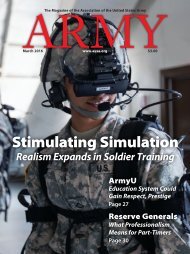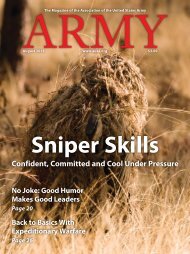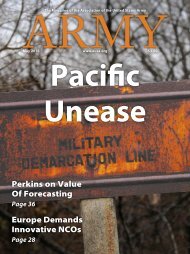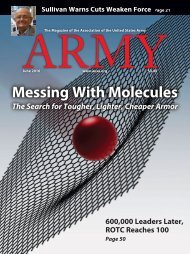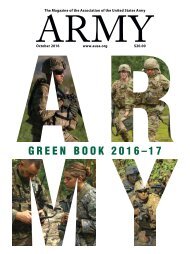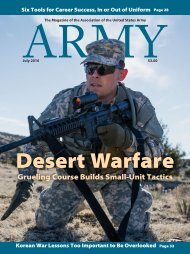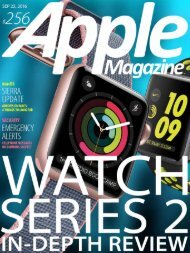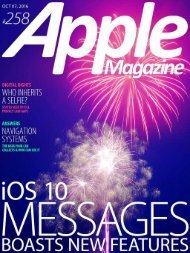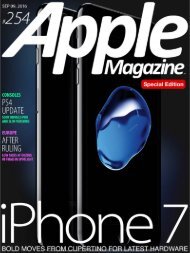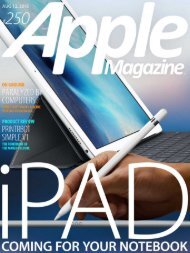Army - Kicking Tires On Jltv
Create successful ePaper yourself
Turn your PDF publications into a flip-book with our unique Google optimized e-Paper software.
U.S. <strong>Army</strong>/Sgt. 1st Class John D. Brown<br />
Leaders from the 1st Brigade Combat Team, 101st Airborne Division, discuss ethically challenging<br />
situations during a professional development program at Fort Campbell, Ky.<br />
ing and burdensome requirements, and the accepted norm of<br />
telling higher headquarters what they want to hear.<br />
Wong and Gerras are known to be provocative in asking<br />
tough questions and publishing research findings that are uncomfortable<br />
for military members. Ultimately, they challenge<br />
the self-image and professional identity of <strong>Army</strong> officers as well<br />
as the <strong>Army</strong> profession itself. Self-image and identity contribute<br />
to the frame of reference developed through career imprinting<br />
from the first unit assignment.<br />
Monica C. Higgins, a professor in education leadership at<br />
the Harvard Graduate School of Education, offers that career<br />
imprinting is a “form of learning that encompasses the professional<br />
impression left on individuals by an organization.”<br />
Given that career imprinting influences individual leader<br />
choices and behavior in an organizational context, then it<br />
would also affect the ethical climate of a unit set by its leaders.<br />
In an article last spring for the U.S. <strong>Army</strong> War College quarterly<br />
Parameters, I asserted that the <strong>Army</strong>’s recent focus has<br />
been on the lack of character of individual leaders and of their<br />
supporting staff to confront and mitigate unethical behavior. A<br />
missing component is an appreciation for a unit climate that<br />
discourages ethical behavior. Importantly, organizational scholars<br />
Linda K. Trevino, Gary R. Weaver and Scott J. Reynolds<br />
offer that ethical climate is “a shared perception among organization<br />
members regarding the criteria … of ethical reasoning<br />
within an organization.” This perception is formed through the<br />
day-to-day experience of unit members of what is acceptable,<br />
and by observing the interactions of leaders and subordinates.<br />
Lack of Survey Instrument<br />
Unfortunately, neither the <strong>Army</strong> nor DoD employs a validated<br />
survey instrument to assess ethical climates within units.<br />
The Government Accountability Office noted that the senior<br />
advisor for military professionalism office<br />
was completing an inventory of climate,<br />
professional development and psychometric<br />
tools that are used across the department<br />
to enhance interdepartmental<br />
visibility of these tools and promote best<br />
practices, and that the office staff “stated<br />
that while these tools could be used to<br />
assess ethics-related issues, none of the<br />
tools were designed exclusively for that<br />
purpose.”<br />
It is puzzling that DoD would consider<br />
using survey instruments inappropriate<br />
to assess something as important<br />
as ethical climate. Rather than rely on<br />
anecdotal evidence or the gut feel of senior<br />
leaders far removed from units, it<br />
would be prudent for the <strong>Army</strong> to either<br />
develop a survey instrument or adapt an<br />
existing tool specifically designed to assess<br />
ethical climate. <strong>On</strong>e such available<br />
tool is the Ethical Climate Questionnaire, a valid assessment<br />
instrument that measures five dimensions of climate developed<br />
from scholarly research.<br />
My sense of that aspect of a unit climate was not based on<br />
formal survey but from my own career imprinting with an assignment<br />
to a field artillery battalion in a mechanized division<br />
during the height of the Cold War. Imagine being a young<br />
lieutenant or junior NCO in Germany in the late 1970s, when<br />
<strong>Army</strong> units were stationed on overcrowded kasernes and<br />
subinstallations; units shared headquarters buildings, barracks,<br />
maintenance bays and motor pools. Our artillery battalion collocated<br />
its vehicle parking area with the division cavalry<br />
squadron and an engineer company.<br />
With the shared parking, there were concurrent nightly<br />
guard mounts, ostensibly to protect the equipment from offpost<br />
outsiders. In reality, the unit guards were protecting their<br />
vehicles and equipment from “midnight requisitions” by other<br />
units. Many of us remember painting the bumper numbers on<br />
the canvas doors of our vehicles—jeeps, Gama Goats and<br />
GOERs—only to be dismayed when those items still disappeared<br />
overnight.<br />
For proper supply accountability, <strong>Army</strong> regulations required<br />
hand receipts for property, and periodic inventory. Shortage<br />
annexes documented missing items and components for vehicles,<br />
sets, kits and outfits. It was common practice to update<br />
hand receipts after maneuver exercises, and record “field<br />
losses” on shortage annexes. Part of command supply discipline<br />
was to engrave unit designation on the components of<br />
the various tool kits. While the practice may have aided accountability<br />
during inventory, it was more likely to facilitate<br />
recovery from those who had “borrowed” the tool. I remember<br />
the absurdity as the maintenance sergeant attempted to engrave<br />
a set of Allen wrenches.<br />
Col. Charles D. Allen, USA Ret., is professor of leadership and cultural<br />
studies in the Department of Command, Leadership and<br />
Management at the U.S. <strong>Army</strong> War College.<br />
‘Get It Done’<br />
A critical event for each leader was the unit’s annual general<br />
inspection. With its numerous checklists and metrics, the in-<br />
30 ARMY ■ February 2016




